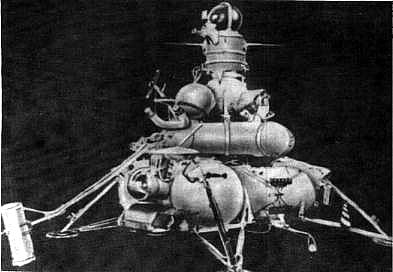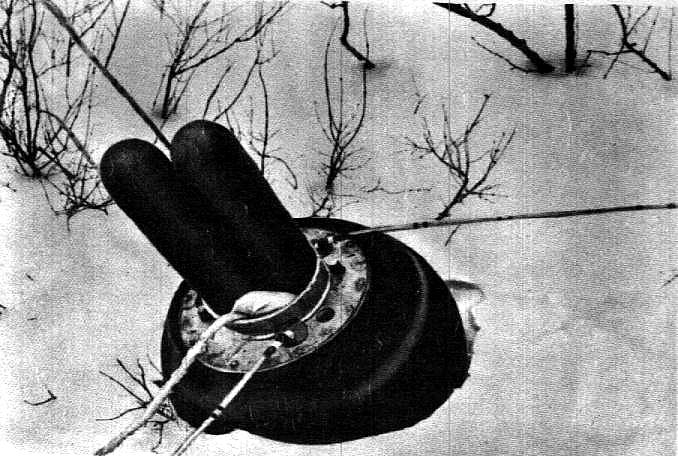Collecting the samples of lunar soil and delivery them to Earth was a part of the Luna program, that included a series of robotic spacecraft missions sent to the Moon by the Soviet Union between 1959 and 1976. The lunar soil samples were successfully retrieved by Luna-16, Luna-20 and Luna-24 probes. All these spacecrafts had the equal main stages of the flight: soft landing on Moon, launch of the lunar soil sample return capsule, and parachute assisted landing back on Earth.[1-4]
Luna-16 probe consisted of two attached stages, an ascent stage mounted on top of a descent stage. The descent stage was a cylindrical body with four protruding landing legs, fuel tanks, a landing radar, and a dual descent engine complex. The spacecraft descent stage was equipped with a television camera, radiation and temperature monitors, telecommunications equipment, and an extendable arm with a drilling rig for the collection of a lunar soil sample. The descent stage also acted as a launch pad for the ascent stage. The ascent stage was a smaller cylinder with a rounded top. It carried a cylindrical hermetically sealed soil sample container inside a re-entry capsule.[5-7]
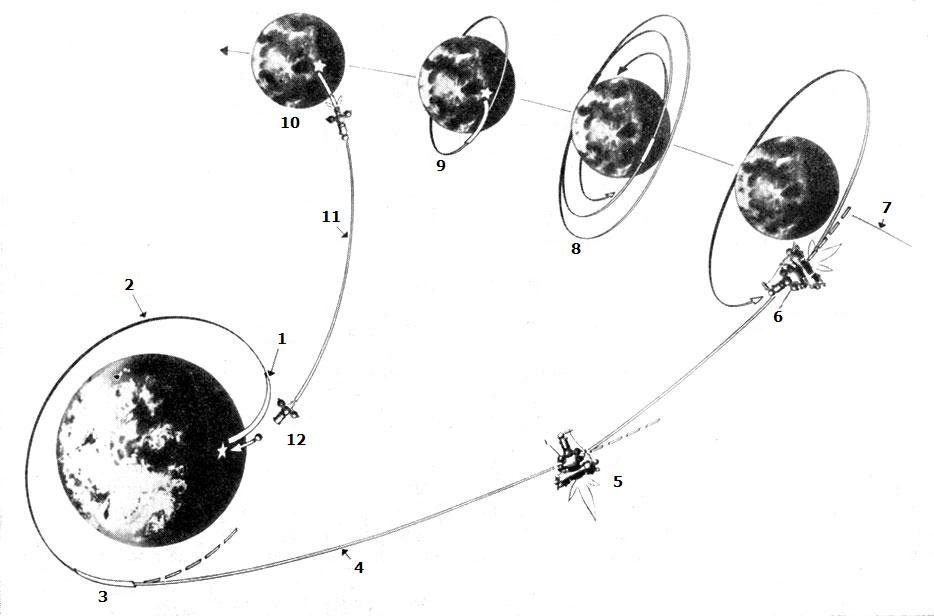
The Flight scheme of Luna-16 probe: 1 – Launch to the orbit of the Earth’s satellite; 2 – Flight on the Earth’s satellite orbit; 3 – Acceleration; 4 – Earth-Moon flight route; 5 – Correction; 6 – Braking and entering into orbit around the Moon; 7 – Moon’s orbit; 8 – Maneuvering on lunar orbit; 9 – Braking and soft landing; 10 – Take-off from the Moon’s surface; 11 – Moon-Earth flight route; 12 – Separation of the Return capsule and rocket. [37]
Luna-16 was launched by rocket “Proton-K/D” from Baikonur Cosmodrome on September 12, 1970. The trajectory of the spacecraft was corrected on September 13, 1970 (that provided an entering to the calculated point of near-moon space). The probe launched into orbit around the Moon on September 17, 1970. The lunar gravity was studied from this orbit. The spacecraft safely soft-landed in its target area known as the Sea of Fertility on September 20, 1970. The mass of spacecraft at landing was 1,880 kilograms.[5-7]
Less than an hour after landing, an automatic drill penetrated the lunar surface to collect a soil sample. After drilling for 7 minutes, the drill reached a stop at 35 centimeters depth. The column of regolith in the drill tube was then transferred to the soil sample container.[5-7]
Finally, on 21 September, 1970, after 26 hours and 25 minutes on the lunar surface, the spacecraft’s ascent stage (its mass was 512 kilograms) lifted off to Earth. The lower stage of Luna-16 remained on the lunar surface and continued transmission of lunar temperature and radiation data. Three days later, on 24 September, 1970, the capsule (its mass was 35 kilograms) with lunar soil reentered Earth’s atmosphere, and parachuted down 80 kilometers southeast of the town of Jezkazgan in the Kazakh SSR (now – the Republic of Kazakhstan).[5-7]
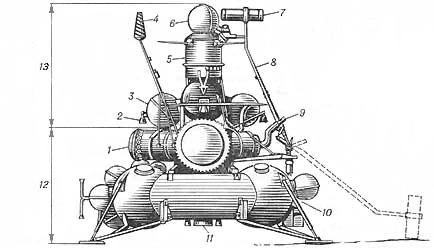
Scheme of Luna-20 probe: 1 – instrument module of descent stage; 2 – control nozzles; 3 – rocket fuel tanks; 4 – antenna; 5 – instrument section of missile; 6 – return capsule; 7 – drilling mechanism; 8 – rod of drill mechanism; 9 – telephotometer; 10 – fuel tank; 11 – propulsion system of descent stage; 12 – descent stage; 13 – rocket Moon-Earth. [35]
Luna-20 probe was the second of three successful Soviet lunar sample return missions. On February 14, 1972, rocket “Proton-K/D” launched Luna-20 from Baikonur Cosmodrome to Moon. On February 15, 1972, the flight path of spacecraft was corrected. Luna-20 entered lunar orbit on February 18, 1972. On February 21, 1972, Luna-20 probe soft landed on the Moon in a mountainous area near Sea of Fertility, 120 km from where Luna-16 had landed. While on the lunar surface, the panoramic television system was operated. Like Luna-16, lunar samples were obtained by means of an extendable drilling apparatus. The ascent stage of Luna-20 was launched from the lunar surface on February 22, 1972, carrying lunar samples in a sealed capsule. It landed 40 kilometers north-west of the town of Jezkazgan on February 25, 1972. The lunar samples were recovered the following day.[8-10]
The last of the Luna series of spacecraft, the mission of the Luna-24 probe was the third Soviet mission to retrieve lunar soil samples from the Earth’s moon. Luna-24 was launched by rocket “Proton-K/D” from Baikonur Cosmodrome on August 9, 1976. After a trajectory correction on August 11, 1976, Luna-24 entered lunar orbit three days later. The spacecraft orbital dry mass was 4,800 kg. After further changes to its orbit, Luna-24 set down safely on the lunar surface in the area known as Sea of Crisis on August 18, 1976. Under command from ground control, the lander deployed its sample arm and pushed its drilling head about 2 meters into the nearby soil. The sample was safely stowed in the small return capsule, and after nearly a day on the Moon, Luna-24 lifted off successfully on August 19, 1976. Luna 24’s capsule entered Earth’s atmosphere and parachuted safely to land on August 22, 1976, about 200 kilometers south-east of the town of Surgut in Russian SFSR (now – the Russian Federation).[11][12]
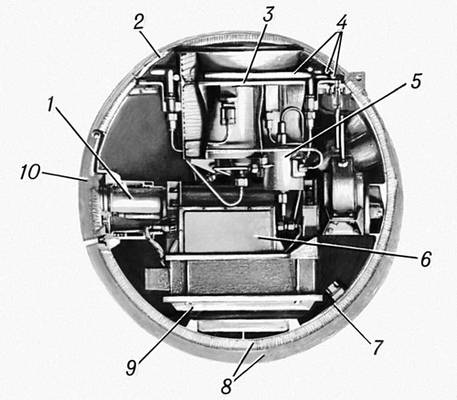
Scheme of Luna-20’s Return capsule: 1 – container for soil; 2 – parachute compartment cover; 3 – parachute compartment; 4 – antennas; 5 – antenna switch; 6 – transmitters; 7 – case of return capsule; 8 – lagging; 9 – battery; 10 – cover. [25]
Luna-16 was a landmark success for the Soviet Union in its deep space exploration program. This mission accomplished the first fully automatic recovery of soil samples from the surface of an extraterrestrial body. Also the strong and good quality television pictures were returned by the Luna-16 spacecraft.[5]
The following amount of the lunar soil was successfully delivered by Soviet automatic stations: Luna-16 (1970) – 101 grams, Luna-20 (1972) – 55 grams, Luna-24 (1976) – 170 grams.[5-12]
Like the Luna-16 soil, samples of the Luna-20 collection were shared with American and French scientists. Also the Soviet Union swapped a gram of the Luna-24 mission sample for a lunar sample from NASA in December 1976.[5-12] Three tiny samples (0.2 grams) of the Luna-16 soil were sold at Sotheby auction in 1993.[5]
Luna-24 was the last lunar spacecraft to be launched by the Soviet Union.[11] The analysis of the results of Luna-24 flight was the first obtained conclusive evidence of water on Moon.[12]
NASA announced that the exact locations of Luna-16, Luna-20 and Luna-24 descent stages on the lunar surface had been found by the Lunar Reconnaissance Orbiter probe orbital cameras.[5-12]
References:
1. Sample return mission. – Mode of access: http://en.wikipedia.org/wiki/Sample_return_mission.
2. Luna programme. – Mode of access: http://en.wikipedia.org/wiki/Luna_program.
3. Космічна програма «Луна». – Mode of access: http://uk.wikipedia.org/wiki/%D0%9A%D0%BE%D1%81%D0%BC%D1%96%D1%87%D0%BD%D0%B0_%D0%BF%D1%80%D0%BE%D0%B3%D1%80%D0%B0%D0%BC%D0%B0_%C2%AB%D0%9B%D1%83%D0%BD%D0%B0%C2%BB.
4. Луна (космическая программа). – Mode of access: http://ru.wikipedia.org/wiki/%D0%9B%D1%83%D0%BD%D0%B0_%28%D0%BA%D0%BE%D1%81%D0%BC%D0%B8%D1%87%D0%B5%D1%81%D0%BA%D0%B0%D1%8F_%D0%BF%D1%80%D0%BE%D0%B3%D1%80%D0%B0%D0%BC%D0%BC%D0%B0%29.
5. Luna 16. – Mode of access: http://en.wikipedia.org/wiki/Luna_16.
6. Луна-16. – Mode of access: http://uk.wikipedia.org/wiki/%D0%9B%D1%83%D0%BD%D0%B0-16.
7. Луна-16. – Mode of access: http://ru.wikipedia.org/wiki/%D0%9B%D1%83%D0%BD%D0%B0-16.
8. Luna 20. – Mode of access: http://en.wikipedia.org/wiki/Luna_20.
9. Луна-20. – Mode of access: http://uk.wikipedia.org/wiki/%D0%9B%D1%83%D0%BD%D0%B0-20.
10. Луна-20. – Mode of access: http://ru.wikipedia.org/wiki/%D0%9B%D1%83%D0%BD%D0%B0-20.
11. Luna 24. – Mode of access: http://en.wikipedia.org/wiki/Luna_24.
12. Луна-24. – Mode of access: http://ru.wikipedia.org/wiki/%D0%9B%D1%83%D0%BD%D0%B0-24.
13. laspace.ru :: НПО им. С.А. Лавочкина // Автоматическая станция “Луна-16”. – Mode of access: http://www.laspace.ru/rus/luna16.html.
14. laspace.ru :: НПО им. С.А. Лавочкина // Автоматическая станция “Луна-20”. – Mode of access: http://www.laspace.ru/rus/luna20.html.
15. laspace.ru :: НПО им. С.А. Лавочкина // Автоматическая станция “Луна-24”. – Mode of access: http://www.laspace.ru/rus/luna24.html.
16. Luna 16 // NASA – NSSDC – Spacecraft – Details. – Mode of access: http://nssdc.gsfc.nasa.gov/nmc/spacecraftDisplay.do?id=1970-072A.
17. Luna 16. – Mode of access: http://nssdc.gsfc.nasa.gov/image/spacecraft/luna-16.jpg.
18. Luna 20 // NASA – NSSDC – Spacecraft – Details. – Mode of access: http://nssdc.gsfc.nasa.gov/nmc/spacecraftDisplay.do?id=1972-007A.
19. Luna 20. – Mode of access: http://nssdc.gsfc.nasa.gov/image/spacecraft/luna-20_ret.jpg.
20. Luna 24 // NASA – NSSDC – Spacecraft – Details. – Mode of access: http://nssdc.gsfc.nasa.gov/nmc/spacecraftDisplay.do?id=1976-081A.
21. Luna 24 Descent Craft // NASA – NSSDC – Spacecraft – Details. – Mode of access: http://nssdc.gsfc.nasa.gov/nmc/spacecraftDisplay.do?id=1976-081E.
22. Luna 24 Descent Craft. – Mode of access: http://nssdc.gsfc.nasa.gov/image/spacecraft/luna24.jpg.
23. БСЭ // «Луна». – Mode of access: http://bse.sci-lib.com/article071687.html.
24. БСЭ // «Луна-16». – Mode of access: http://bse.sci-lib.com/a_pictures/18/10/253400406.jpg.
25. БСЭ // Возвращаемый аппарат АМС «Луна-20». – Mode of access: http://bse.sci-lib.com/a_pictures/18/10/265782910.jpg.
26. Лунные полеты // Лунные зонды СССР. – Mode of access: http://www.astronaut.ru/luna/ussr_a3.htm.
27. USSR – Luna 16. – Mode of access: http://www.zarya.info/Diaries/Luna/Luna16.php.
28. USSR – Luna 24. – Mode of access: http://www.zarya.info/Diaries/Luna/Luna24.php.
29. Эпизоды космонавтики // Таблица запусков АЛС 61-70. – Mode of access: http://epizodsspace.no-ip.org/e2/tab/zap-als61-70.html.
30. «Луна-16»: Космический геолог / сост. Б. Коновалов. – М. : Известия, 1970. – 192 с.
31. Эпизоды космонавтики // Луна-16 обл. – Mode of access: http://epizodsspace.no-ip.org/bibl/l-16/obl.html.
32. Эпизоды космонавтики // 1971. – Mode of access: http://epizodsspace.no-ip.org/bibl/ejeg/1971/71.html#l16.
33. Эпизоды космонавтики // Таблица запусков АЛС 71-80. – Mode of access: http://epizodsspace.no-ip.org/e2/tab/zap-als71-80.html.
34. Эпизоды космонавтики // 1973. – Mode of access: http://epizodsspace.no-ip.org/bibl/ejeg/1973/73.html#l20.
35. Автоматическая станция «Луна-20». – Mode of access: http://epizodsspace.no-ip.org/bibl/ejeg/1973/73-1.jpg.
36. Эпизоды космонавтики // 1977. – Mode of access: http://epizodsspace.no-ip.org/bibl/ejeg/1977/77.html#l24.
37. Алексеев В. За лунным камнем / В. Алексеев, Л. Лебедев. – М. : Машиностроение, 1972. – 120 с.
38. За лунным камнем. – Mode of access: http://epizodsspace.airbase.ru/bibl/alekseev/za-lunn-kam/01.html.
39. Иванов А. Реголит из Моря Изобилия / А.Иванов, Ю.Стахеев, Л.Тарасов // Наука и жизнь. – 1971. – N 1. – С. 60–65, обл.1-2.
40. Гэтланд К. Космическая техника: Иллюстрированная энциклопедия / К. Гэтланд. – М. : Мир, 1986. – 294 с.
41. Полеты АМС к Луне. – Mode of access: http://www.epizodsspace.narod.ru/bibl/getlend/09.html.
42. Gatland K. The Illustrated Encyclopedia of Space Technology / Kenneth William Gatland. – [2 Rev Sub edition]. – New York : Crown, 1990.
43. Angelo, Joseph A. Robot spacecraft / Joseph A. Angelo, Jr. – New York : Facts On File, Inc., 2007. – 306 p.
44. Lunar Reconnaissance Orbiter. – Mode of access: http://en.wikipedia.org/wiki/Lunar_Reconnaissance_Orbiter.
45. Lunar Reconnaissance Orbiter. – Mode of access: http://uk.wikipedia.org/wiki/Lunar_Reconnaissance_Orbiter.
46. Lunar Reconnaissance Orbiter. – Mode of access: http://ru.wikipedia.org/wiki/Lunar_Reconnaissance_Orbiter.
1 This file is in the public domain because it was created by NASA.
